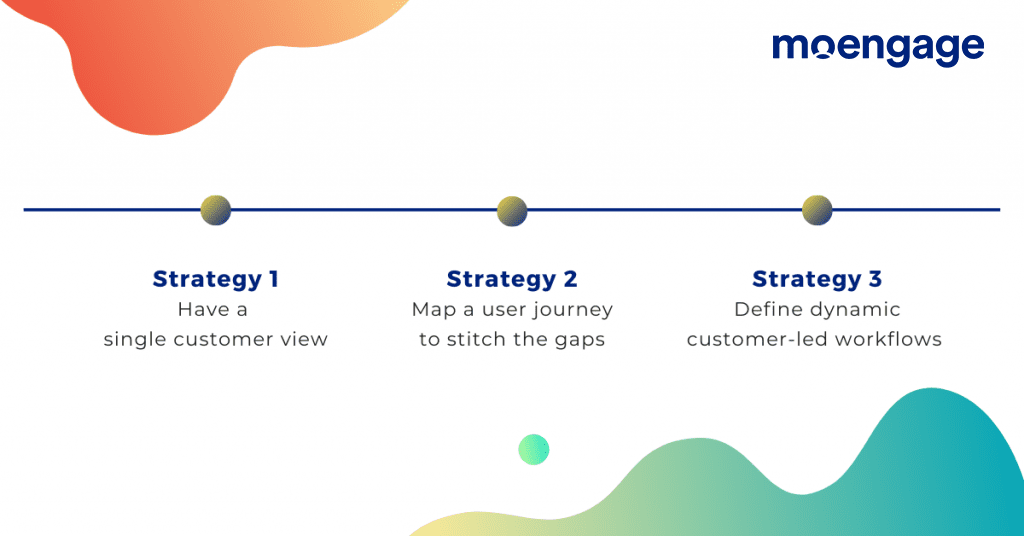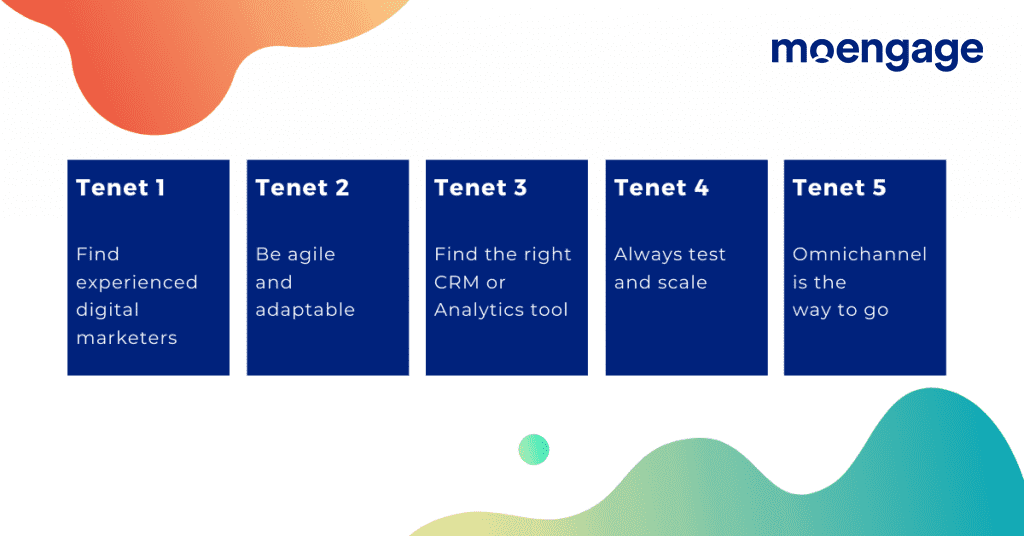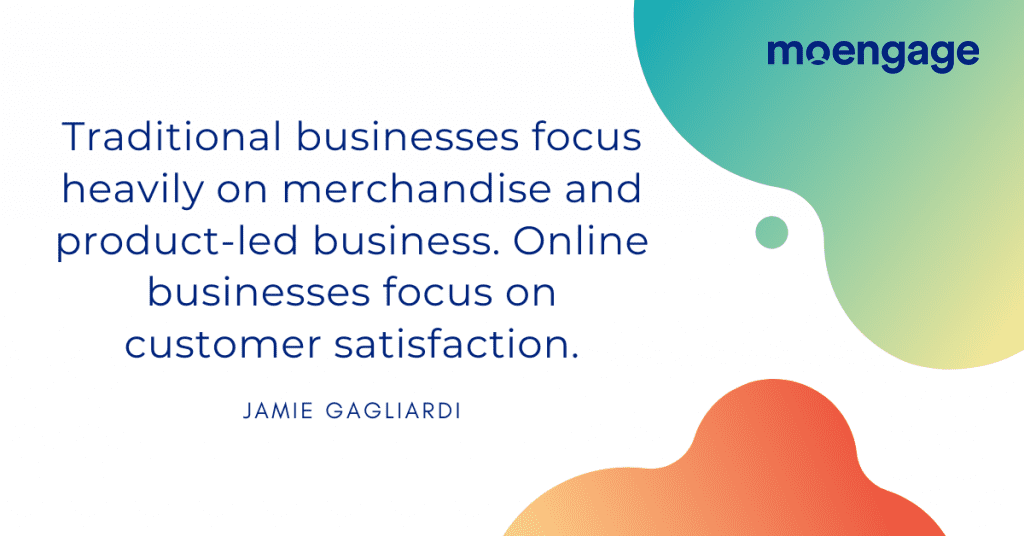[Customer Spotlight] Retail Omnichannel Growth Strategies from JimmyBrings
![[Customer Spotlight] Retail Omnichannel Growth Strategies from JimmyBrings](https://www.moengage.com/wp-content/uploads/2020/07/growth-strategy-with-jamie-1.png)
Reading Time: 7 minutes
Editor’s note: Customer Spotlight is an initiative by MoEngage, where we talk to our customers to understand their growth strategy, engagement tactics, and best practices across product & marketing.
We all know the impact of the pandemic on consumer businesses and the shift in consumer buying behavior. Now with some brands planning to re-open businesses and some trying to sustain the current business model; we thought of discussing how this new normal might change the way you engage with your audience. So here I’m today with an insightful discussion on customer-centric marketing in the new normal.
| Bonus Content
👉 Beginner’s Guide to Omnichannel Marketing for 2021 [Download Ebook] 👉 Retail Strategies and Omnichannel Engagement Frameworks [Download Ebook] |
Jamie Gagliardi heads Marketing at JimmyBrings, an alcohol delivery service in Australia. He unveils how he factors in customer needs when planning growth strategies in omnichannel retail.
He shares notable experiences from JimmyBrings’ growth journey.
Tell us about your professional experience and your current role at Jimmy Brings?
Jamie: I started out in retail the same way as most of us do, as a sales associate, at my local Toys R Us store. While working there, I always thought to myself that ‘there’s a better way to do this’, or ‘that’s not a customer-friendly solution’ when it came to marketing communication.
Later, I applied for a customer service specialist role and quickly understood the challenges experienced by customers. After a year, I moved to a different department as an Inventory Planner. I worked in this role for two years until I graduated with a Degree in Commerce.
During this time, Toys R Us realized the omnichannel business model was what customers were expecting within the retail landscape. Having an online presence became the core strategy for the brand and I moved to their marketing team. I worked closely to move their legacy digital marketing tools into a more sophisticated CRM platform. There were no active automated campaigns and no segmentation, rather a “spray and pray” approach.
But after the platform integration, my role transformed into a Digital Communications Specialist. Here I used my past learning to build key segments and define a communication strategy.
The strategy helped us drive our in-store loyalty program that connected offline data to our online e-commerce data. We were able to build a single customer view of all our customers with this strategy.
Then I joined Jimmy Brings as the Marketing Head overseeing CRM and digital marketing channels. I quickly realized that as a pure-play e-commerce business, a digital-first media was the need. This backed by data insights was the strategy for growth and new customer acquisition. We grew our service availability from 2 to 8 cities in under two years. Currently, our business is four times the size as last year.
How did the transition from offline to online marketing influence the way you build an omnichannel growth strategy?
In my time working with offline marketing, I realized it is easy to lose track of key metrics that actually help build strong marketing. For me, these metrics are customer growth, retention, and brand perception. These three things are at the core and really fundamental to marketing strategy.
The benefit of having an online business is it allows us to track data across all sources of customer journeys. We don’t have the lost link of offline data. So, the struggle of being an offline marketer is that it is tougher to quantify your contributions in terms of ROI. That’s why legacy systems are built that way—they don’t really measure success.
At an online level, you can quickly transition to a strategy and adapt it to what customers want. That is the benefit of having an online business. Traditional businesses focus heavily on merchandise and product-led business, and it’s about what you are selling. Online businesses focus on customer satisfaction.
How has mapping customer behavior improved your omnichannel growth strategy?
Let me take the example of JimmyBrings — it is an app-first business but our customers come to our website too. This makes it crucial for me to know where the customers go and how the journey takes place. Currently, we are on a journey to place together a single customer view across all touchpoints. This is because my experience with offline marketing made me realize that without a complete customer view you can’t fill the gaps. Let me cite some strategies and examples for the same.
Strategy 1: Build a single customer view and then build an omnichannel growth strategy.
For example, we know that for an abandoned cart user, push notification works better than email. And having that data in one place with a holistic view enables us to make quick changes that influence conversions.
Another example is to understand if customers are engaging more with our app or our website. A single view will unlock other unexplored functions for most retailers, including conversion rate optimization to ensure we optimize our upper funnel, as well as lower funnel.
Strategy 2: Map user journeys to stitch the gaps in your omnichannel marketing funnel.
For example, analyzing when a customer comes to my website but completes the purchase on the app informs me that the website is informative, but sales actually happen in the app. So now I’ll focus on transitioning landing pages to focus heavily on informing and taking users on that journey.

Another example is to create a roadmap to understand user pathways. For example, the most common pathway for a first time user could be an exposure to a Facebook or a Google ad and then a Google search to organic click. Based on this user flow you should weigh the campaign budget. Optimizing spends by altering creatives based on pathways is a good strategy.
Strategy 3: Define dynamic workflows that are customer-led, not product-led using relevant personalization.
For example, to accurately prospect for new customers—create a campaign excluding existing customers from the campaign with an engaging and informative messaging. This messaging is to warm-up new customers to your brand and is, in contrast, to retargeting campaign messaging for existing customers i.e., more deal-oriented.
What are the 5 tenets that traditional retailers should follow to adopt omnichannel growth strategies?
There are few things I have learned along the way that I think marketers can apply while transitioning the business from offline to digital.
1. Find experienced digital marketers
The first step is to get experienced digital marketers, and if possible, upskill your current workforce. It is a complex area that probably doesn’t need experts in each specialization, but there is a lot to understand.
It will be best to upskill your workforce and get them to understand the basics of the digital marketing landscape. Even if you work with agencies, it’s great to have someone in-house that knows what they are talking about to speak the same language and to actually get the most value out of these agencies.
2. Be agile and adaptable
Next is to be agile and adaptable and it mostly depends on how you execute your plans. It’s not bad to have a 6-month, one-year, or 5-year roadmap. Take this pandemic, for example. If I have a roadmap, I analyze the previous and next 3 months to understand what happened and what will happen. Based on this, I can relook at some strategies to make it work and de-prioritize or re-prioritize things to keep on the roadmap. So, having an agile mindset is quite important for these kinds of transitions because nothing is going to go the way you planned.
3. Find the right CRM/Analytics tools
The next step is to utilize the right CRM or analytics tools to help you sieve through all the data collected over the years. Having data is one thing but knowing how to use it is another ballgame. I think once you start collecting all this online data, how are you going to measure metrics and explain it to key stakeholders matters. So find either an enterprise tool if you are at that scale or a small business tool if you are just starting but this is something you must invest time in.

4. Always test and then scale
Testing and scaling channels are very important especially if you are tipping your toes in different territories. Having a massive budget into one channel and not knowing what it is going to do to your business is probably not the best strategy. I think diversifying that and understanding what responds well to your business is the best way of doing it because not all businesses will react to the same channels and it’s always about testing and scaling if that works.
5. Omnichannel is the way to go
Lastly, if you have the option, an omnichannel strategy is probably what you want to deem as the end goal. Don’t discount what you are doing in-store but don’t discount what you are doing online as well. They should talk to each other and complement each other. I think having one brand is what customers see, they don’t see your brand as an online brand or a brick-and-mortar brand.
So, internally you shouldn’t be competing with either of the channels. You should be taking the customer along the journey wherever they want to shop—whether it is to try and buy in the physical store or click to buy on an app. Leave that choice to the convenience of your end customer. But ensure the journey from finding the product to purchasing the product is smooth and synced with all platforms and channels.

Thank you, Jamie, for sharing your knowledge about diversifying marketing strategies based on customer data. Have questions on optimum ways marketers from retail companies can smoothly transition from offline to online channels? Drop us a line below.
Here’s what you should do next
|







